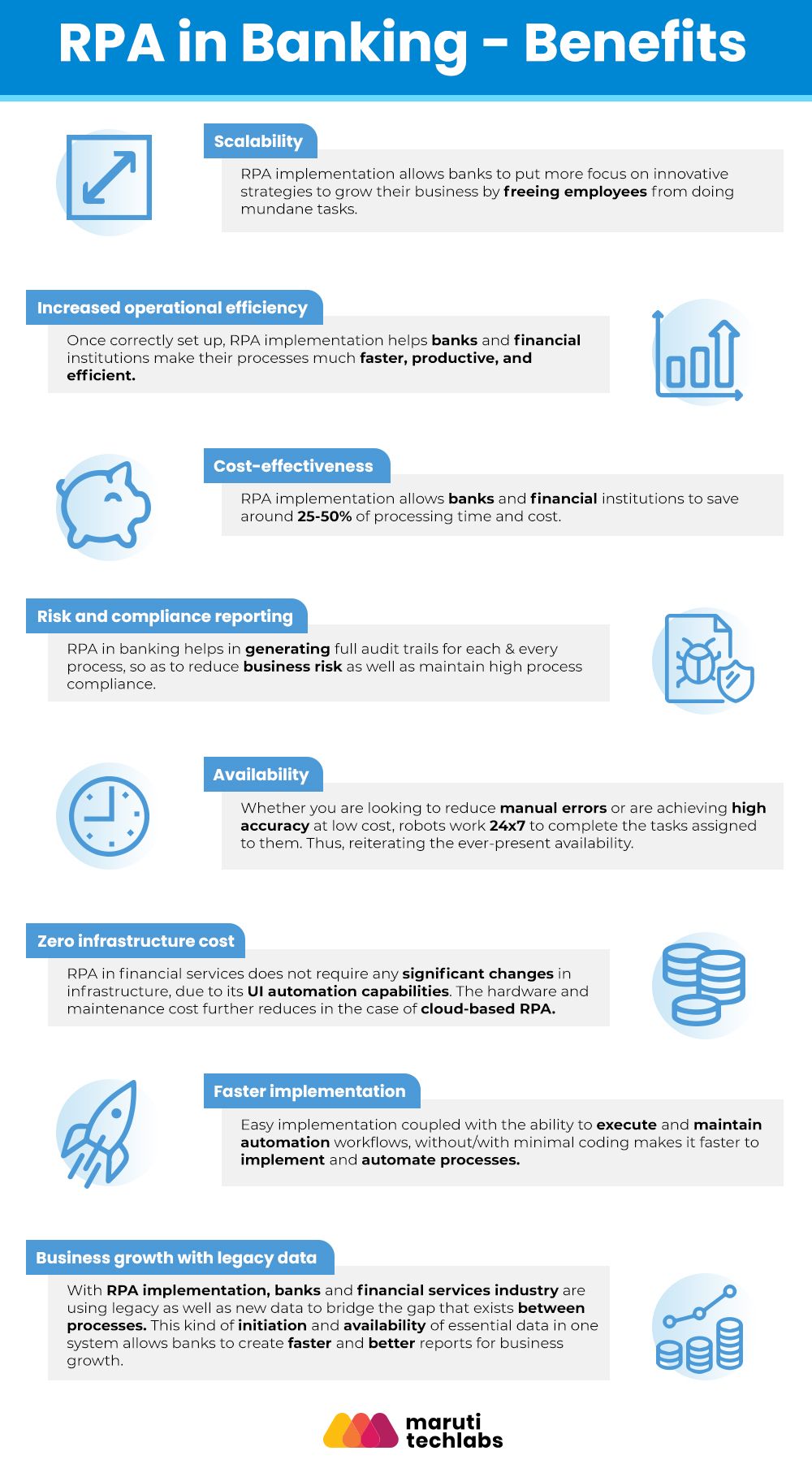Robotic Process Automation in Banking: Use Cases & Benefits
In an increasingly saturated banking & financial sector (especially with the massive counter competition from FinTech and other virtual banking solutions) it has become imperative for banks & other financial institutions to continually evolve, remain competitive, and provide exceptional customer experience to users.
Banks & financial institutions today are under tremendous pressure to optimize costs and boost productivity. The banking sector has faced challenges concerning skilled resources, inefficient processes, and cost management. This led to the adoption of automation. However, choosing between Robotic Process Automation vs Traditional Automation requires an in-depth analysis of your business needs and objectives.
In this blog, we are going to discuss various aspects of RPA in the banking and financial services sector along with its benefits, opportunities, implementation strategy, and use cases.
Robotic Process Automation In Banking
Robotics in banking & finance is primarily defined as the use of a powerful robotic process automation software to –
- Install desktop and other end-user device-level software robots
- Build artificial intelligence workforce or virtual assistants
RPA in the banking industry serves as a useful tool to address the pressing demands of the banking sector and help them maximize their efficiency by reducing costs with the services-through-software model.
To seize this opportunity, banks and financial institutions must adapt a strategic, and not tactical, approach. McKinsey foresees a second wave of automation and AI in the next couple years where machines & software bots will execute 10% to 25% of tasks across a myriad of bank functions, expanding the overall capacity and giving the workforce an opportunity to focus on higher-value tasks and projects.
The exponential growth of RPA in financial services can be estimated by the fact that the industry is going to be worth a whopping $2.9 billion by 2022, a sharp increase from $250 million in 2016, as per a recent report.
Power of Automation in Banking
Over the last decade, banks and financial institutions are reported to have spent more than $321 billion on compliance operations as well as fines. Banks are estimated to disburse nearly $270 billion yearly, just on compliance operations. Almost more than 10% of a bank’s operating cost is attributed to compliance costs.
Rising operating expenses, compounded by regulatory fines along with fierce regulatory requirements slow processes down as well as influence and result in a poor customer experience. Throwing more people at the problem of finding new and better ways to manage compliance, while cutting down operational expenses is definitely not the answer.
Robotic Process Automation can enables banks & finance companies to reduce manual efforts, offer better compliance, mitigate risks, and enhance the overall consumer experience. Moreover, what makes automation most suitable for banks and financial institutions is that there are no additional infrastructure requirements coupled with its low-code approach.
Wondering how? Read on.
The primary aim of RPA in the banking industry is to assist in processing the banking work that is repetitive in nature. Robotic process automation (RPA) helps banks & financial institutions increase their productivity by engaging customers in real-time and leveraging the immense benefits of robots.
RPA is an extensive process, requiring robust employee training, structured inputs, and governance. However, once set up and implemented correctly, these RPA-based banking robots can take complete control of the system (mouse and keyboard) actions, including clicking & opening applications, sending emails, and copy-pasting information from one banking system to another.
Working in a similar fashion to the excel macro, these robots are made to work at the individual data field level across banking software systems for seamless functioning.
RPA Use-Cases in Banking
Since RPA can be applied to a large number of business process automation projects, there are various well-defined use-cases in this space.

Here, we are going to discuss a few of these use-cases in the banking industry along with examples:
- Automatic Report Generation
Generating compliance reports for fraudulent transactions in the form of suspicious activity reports or SARs is a regular requirement at banks and financial institutions. Conventionally, compliance officers are supposed to read all the reports manually and fill in the necessary details in the SAR form. This makes it an extremely repetitive task which takes a lot of time and effort.
RPA technology, with natural language generation capabilities, can read through these lengthy compliance documents before extracting the required information and filing the SAR. For optimal results, the RPA software can be trained with inputs from the compliance officers on the parts of each document which best fit each section of the report.
Not only does this help in reducing the operational costs, but also saves the time taken to perform the task.
- Customer onboarding
Customer onboarding in banks is a long, drawn-out process; primarily due to several documents requiring manual verification. RPA can make the process much easier by capturing the data from the KYC documents using the optical character recognition technique (OCR). This data can then be matched against the information provided by the customer in the form.
If there are no discrepancies post the automated matching, the data is automatically entered into the customer management portal. RPA automation in customer onboarding not only helps in avoiding manual errors but also saves a lot of time and effort put in by the employees.
- Know your customer (KYC) and Anti-Money laundering (AML)
The fact that both KYC and AML are extremely data-intensive processes makes them most suitable for RPA. Whether it is automating the manual processes or catching suspicious banking transactions, RPA implementation proved instrumental in terms of saving both time and cost as compared to traditional banking solutions.
- Account opening
With RPA, the otherwise cumbersome account opening process becomes much more straightforward, quicker, and accurate. Automation systematically eliminates the data transcription errors that existed between the core banking system and the new account opening requests, thereby enhancing the data quality of the overall system.
An excellent example of this is global banks using robots in their account opening process to extract information from input forms and subsequently feeding it into different host applications.
The results in the elimination of an error-prone, time-consuming, manual data entry process, and a sharp reduction in TAT while, at the same time, maintaining complete operational accuracy and mitigated costs.
- Mortgage lending
Lending is one of the critical service areas for any financial institution. The fact that the process of mortgage lending is extremely process-driven and time-consuming makes it extremely suitable for RPA automation. RPA technology can be used for effortlessly handling the process (and exceptions as well!) with clearly defined rules.
RPA allows for easy automation of various tasks crucial to the mortgage lending process, including loan initiation, document processing, financial comparisons, and quality control. As a result, the loans can be approved much faster, leading to enhanced customer satisfaction.
Another benefit of RPA in mortgage lending deals with unburdening the employees from doing manual tasks so that they can focus on more high-value tasks for better productivity.
- Loan processing
Loan processing has always been considered as a tediously slow process. Although the bank has automated the process to a certain extent, RPA further accelerates it and brings it down to a record 10-15 minutes for processing.
RPA Opportunities in the Banking and Financial Sector
Banking and financial institutions have always been known for their lengthy, manual processes affecting the overall productivity and customer satisfaction levels negatively.
Implementing RPA in the banking industry gives an excellent opportunity to automate some of the critical banking tasks listed below –
1. Customer service
The volume of everyday customer queries in banks (ranging from balance query to general account information) is enormous, making it difficult for the staff to respond to them with low turnaround time. RPA tools can allow banks to automate such mundane, rule-based processes to effectively respond to queries in real-time, thereby reducing the turnaround time substantially.
2. Credit card processing
One of the other time-consuming processes at banks is credit card applications, which typically take several days for validating the customer information before approving the credit card.
RPA, on the other hand, can help make quick decisions to approve/disapprove the application with a rule-based approach.
3. Account closure process
The number of account closure requests that banks have to deal with monthly is enormous. One reason is the non-compliance on the part of the clients in the submission of mandatory documents.
Robotic Process Automation allows the banks to tackle this issue by easily tracking all such accounts and sending them an automated notification & additional reminders for the submission of the required documents.
Benefits of RPA in Banking & Finance

There are many benefits of RPA in business, including enhanced productivity, efficiency, accuracy, security, and customer service. Let’s briefly observe some of the benefits.
1. Scalability
The fact that robots are highly scalable allows you to manage high volumes during peak business hours by adding more robots and responding to any situation in record time.
Additionally, RPA implementation allows banks to put more focus on innovative strategies to grow their business by freeing employees from doing mundane tasks.
2. Increased operational efficiency
Once correctly set up, banks and financial institutions can make their processes much faster, productive, and efficient.
3. Cost-effectiveness
Similar to any other industry, cost-saving is critical to the banking industry as well. Banks and financial institutions can look at saving around 25-50% of processing time and cost.
4. Risk and compliance reporting
RPA in banking helps in generating full audit trails for each & every process, so as to reduce business risk as well as maintain high process compliance.
5. Availability
Whether you are looking to reduce manual errors or are achieving high accuracy at low cost, robots work 24×7 to complete the tasks assigned to them. Thus, reiterating the ever-present availability.
6. Zero infrastructure cost
One of the benefits of RPA in financial services is that it does not require any significant changes in infrastructure, due to its UI automation capabilities. The hardware and maintenance cost, further reduces in the case of cloud-based RPA.
7. Faster implementation
With RPA tools providing a drag and drop technology to automate banking processes, it is very easy to implement & maintain automation workflows without any (or minimal) coding requirements.
8. Business growth with legacy data
With RPA implementation, banks and financial services industry are using legacy as well as new data to bridge the gap that exists between processes. This kind of initiation and availability of essential data in one system allows banks to create faster and better reports for business growth.
Steps to Deploy RPA in Banking and Finance
Implementing the RPA solution in banking begins with identifying accurate and feasible processes.

Here, we have outlined the important steps which help in successful RPA implementation –
Thorough Assessment
First and foremost, it is crucial to conduct a thorough assessment and detailed analysis to shortlist the processes that are suitable for RPA implementation. Make a list of the main operational issues that can be addressed and resolved through RPA, followed by assessing their impact & feasibility.
Make a business (use) case
In the next step, calculate the cost component and efficiency gains that will be delivered by RPA implementation in your organization. Additionally, conduct a quick comparison of RPA benefits based on various metrics such as time, efficiency, resource utilization, and efforts. Also, make sure to set achievable and realistic targets in terms of ROI (return on investment) and cost -savings to avoid disappointments due to misaligned expectations.
Prepare a comprehensive execution strategy
Based on your specific organizational needs, pick a suitable operating model, and workforce to manage the execution seamlessly. It is crucial at this stage to identify the right partner for end-to-end RPA implementation which would be inclusive of planning, execution, and support.
Remember that not all RPA vendors fit the specific requirements of an organization. Choosing the accurate RPA tool and implementation partner can be instrumental in impacting the final outcomes of the project.
Parting Thoughts
Some banks and financial institutions have already started implementing RPA in their operations, as they serve more like opportunistic and point based solutions that are quick & easier to implement, as compared to large scale transformations.
If implemented properly, Robotic Process Automation services can be genuinely transformative for the banking sector by automating manual, repetitive, and time-consuming tasks. The result of automating such mundane tasks would be seen in the form of enhanced productivity, a sharp reduction in the error rate, and an impressive turnaround time.
However, it is crucial to have a partner with proven expertise in RPA tools & technology throughout the process of implementation. Not only does this bring essential benefits to banks and financial institutions, but it can also guide them about when and how to transition from RPA to other next-gen tools such as AI, CPA (cognitive process automation) and beyond.
At Maruti Techlabs, we have worked on use cases ranging from new business, customer service, report automation, employee on-boarding, service desk automation and more. With a gamut of experience, we have established a highly structured approach to building and deploying RPA solutions. We work hand in hand with you to define an RPA roadmap, select the right tools, create a time boxed PoC, perform governance along with setting up the team and testing the solution before going live.
Interested in learning more about how RPA can serve you? Please contact us HERE.
FAQs
1. How do banks use RPA?
Banks have to deal with huge volumes of data and human overseeing data is always prone to errors. As the stakes are high, a single error can result in legal cases of fraud or theft. This is where RPA can be used in banking where it offers assistance by monitoring transactions, mitigating potential risks, improve compliance by automated regulatory reporting, and more.
2. How does RPA save money?
Robotic process automation can saves tons of money and time by removing manual errors, exponentially increasing process cycle time, enhancing data accuracy, allocation resources efficiently, and by streamlining compliance process.
3. How is RPA used in finance?
RPA produces the most important commodity for finance companies - time. All the departments in finance function on analyzed and structured financial data to make quick and timely decisions. Employing advanced RPA can automate repetitive tasks, improve operational efficiency, and meet compliance mandates.
4. How can RPA improve efficiency in banking?
RPA improves efficiency of many banking processes. Here are its most prominent features.
- Simplified account opening
- Performing customer due diligence (KYC)
- Instant responses to customer queries and routine inquiries like fund transfers, and balance inquiries.
- Automating compliance reporting
- Accounts payable management
5. How can RPA improve compliance in banking?
Compliance activities in banking requires conducting rule based, repetitive tasks. Here are certain areas that can be automated with RPA.
- Eliminating the risk of non compliance by conducting task with enhanced precision and consistency.
- Ensuring consistency and accuracy of data across multiple systems.
- Maintaining detailed audit logs as evidence to following procedures.
- Offering instant corrections by catching anomalies in real time.
- Reducing manual intervention and increased scalability with handling additional workload.
6. What are some things to consider when choosing an RPA tool and implementation partner?
Below is the list of criterias to keep in mind while choosing your RPA tool.
- Architecture
- Intrgrations
- Usability
- Security
- Features
- Exception handling
- Vendor support and documentation
Here are a few things to remember when choosing a RPA implementation partner.
- Experience with your RPA tool
- Proficiency with combining technical expertise and process improvement.
- Choosing the one that offers a transparent cost structure.
- Seeking reliable client references.
- Post implementation support





















